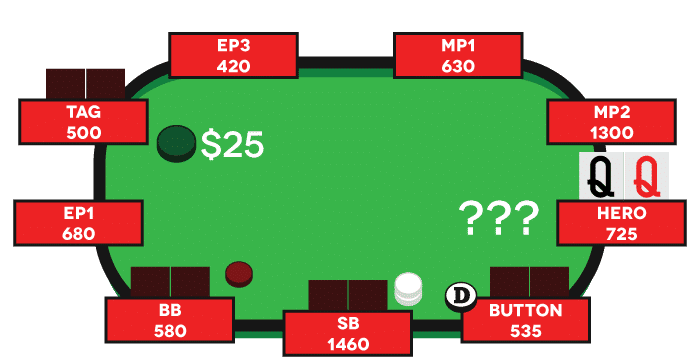“But Queens are a premium hand!” Well, obviously. Many today argue that Queens are the most versatile hand in poker. However, with this versatility comes substantial risk. If you give a powerful wand to the wrong wizard, disaster occurs. Same applies with Queens.
You’re probably asking, what do I mean by all this? We don’t own wands. We have chips, cards, and we’re playing for money, so I should probably get to it.
With that said, I’ll give a few different situations to help illustrate the wide array of options and potential mistakes that can occur with this hand.
Villain, who is a TAG, raises from early position to $25 in your local $2-5 game. It folds around to you on the Cut-Off with QQ. What is the optimal play?

This is a situation where flatting QQ can be optimal. Our early position (EP) raiser is a TAG and is unlikely to continue with hands such as TT/AJ out of position often enough if we 3bet him. Flatting his $25 raise keeps his dominated hands involved. Also, if any players left to act are chronic squeezers it may be beneficial for us to call the $25 and go for the four-bet back raise. If you call with a known squeezer behind you make sure to have a plan when you face the raise though! It is also important to note that if either of the blinds are weak players they are likely to get involved from the blinds with wider ranges and we gain value postflop that way.
So flatting QQ is the default? No.
Let us change the landscape of this hand a bit. Our TAG villain raises from EP to $25, a weak player calls from middle position, and it folds to us on the cut-off again. What is the optimal play now?

Here we can 3bet for value to a size of roughly $95. If we face a 4bet from our early position TAG villain we can comfortably fold, as we expect a live early position TAG player’s 4bet range to consist mostly of KK+/AK,. More importantly, we are 3betting for pure value against the weak caller from middle position. We expect him to make enough mistakes preflop to allow us to 3bet for value and we expect him to continue with worse often.
So 3bet/folding is the default? No.
Recently, I played against a young internet player, who I expect always wears a hoodie to the poker table. I’m sure you’ve seen the type. To be fair, I also am that type and I’m sure he recognized this fact. As admiring as it is to acknowledge the hoodie fashion show, these “hoodie wars” can cause for some interesting live poker dynamics. Let’s get to it:

A weak player limped from middle position and our young hoodie villain isolated him from the Cut-off. I’m on the button with QQ and decide to 3bet. This is where the games begin.
First, lets go over why I decide to 3bet:
1. I do not want our opponent to take every isolation spot throughout the night and beat us to it. We make a lot of money doing that as well. If we 3bet early in the session it can shake our opponent and he will be more reluctant to take every isolation situation. That’s good for us.
2. Our opponent knows that we may have a similar thought process. In other words, he knows that I know he is likely to be isolating without a premium holding here. Moreover, I am capable of exploiting him by 3betting without a premium holding myself, expecting our opponents will fold often enough to show a profit. If he goes down this dark and scary road, our opponent will 4bet ship light a certain percentage of the time in effort to counter. I’d like this now.
The limper folds, our young hoodie opponent shuffles his chips for some time and slowly places some chips forward while announcing all-in. I snap-call. He sighs and mumbles “I need to get lucky”. I hold and don’t make him show (poker etiquette) but I’m sure he had something like 77, A5s, or KJs.
So 3bet/stack-off is the default? No.
If this trend of forever moving parts and multiple answers in regards of one specific hand type is beginning to sound similar; it is because since as long we can remember this was Jacks. However, as the game continues to progress and players become stronger, Queens are beginning to take this role. Some argue that Queens are no longer the powerhouse they once were. However, with the right skill set they can be, similarly to Jacks.
The key to success with Queens today is constant awareness, having a basic plan before making your preflop play, and applying the optimal line to fit the current situation. With the increased aggression poker is played today, any incorrect assumption in regards to your opponents or a misguided range analysis can cost you a buyin with Queens. This is similar to the powerful wand in the wrong wizard’s hand.
As a disclaimer, it is understood that Jacks and Queens are mathematically different. However, the issues many players faced with JJ years ago and still struggle with today are becoming eerily similar to the problems they are facing with Queens as the game continues to evolve.
It is common knowledge that a poker player must keep up with the times or the game with eventually pass him by. The many facets of playing Queens is a small insight into the evolution and direction the game is headed. As you begin to implement multiple lines with these hand types, your game will develop more layers and in turn you will make fewer errors and become highly dynamic.

Christian if my math is right, your 3-bet to $95 in the first example makes the pot $152 including the blinds. If I’m first to act after you, I only have to bet $70 more to win $152, thus getting a strong 2:1 odds to call. If I go a bit larger, say 5x the original raise to $125, I’m giving at least the first villain to act less than 2:1 odds, as the first V is calling $100 to win $175. Is this sizing and strategy solid pre-flop? Thanks as always.